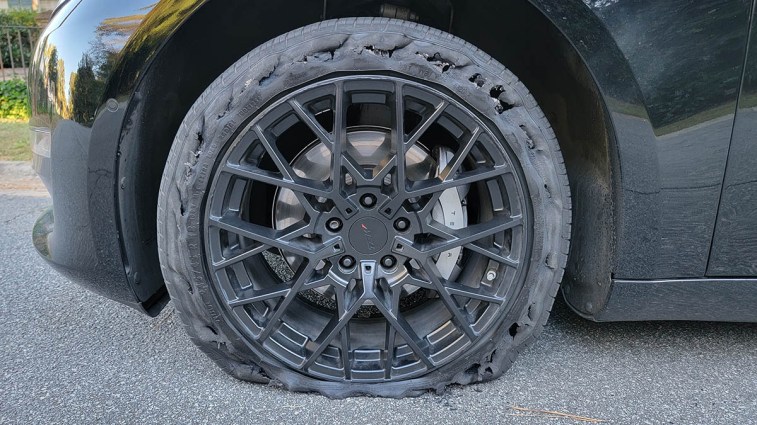A compact spare tire is for temporary emergency use only, and you should drive no more than 50 miles before replacing it. The only purpose of a spare tire is to allow you to drive your vehicle to the nearest shop to repair or replace the flat tire.
Temporary spare tires have limited tread life. Keeping it on your car for a day or two until your first opportunity to get to the tire store might be OK, but only if you limit driving to less than 50 miles during that time. Do not let the tread wear down to the tread wear indicators built into the spare.
What Happens if You Drive Too Far on a Spare Tire?
Your spare tire would likely wear out before causing any significant damage to the car’s transmission. However, your safety is at risk the longer you drive on a spare tire. Driving on a temporary spare decreases your stopping power and overall control, and it increases the likelihood of skidding and hydroplaning.
RELATED: How To Change a Tire
How Fast Can You Drive on a Spare Tire?
Drivers asking, “How far can you drive on a spare tire?” should also know about speed limitations. Do not drive faster than 50 mph on a spare tire.
Emergency spare tires are not replacements and only provide a temporary solution. They lack the traction and durability of regular tires and can’t handle high speeds. Obey warnings about your spare to help avoid tire failure and loss of vehicle control.
Follow this 50-50 rule of thumb when using a temporary emergency spare tire: Drive less than 50 miles, and keep your speed under 50 mph.
RELATED: Car Tires Guide: Everything You Need to Know
Donut Spare Tire vs. Full-Size Spare
The type of spare tire we’ve been discussing is the compact variety for emergency use, sometimes called donut tires. Donut spares are found in most cars because they weigh less and take up less space than a regular-sized spare tire. You cannot safely drive on a donut for more than 50 miles or faster than 50 mph.
Large vehicles, such as full-size pickups and SUVs, are more likely to have full-size spare tires because they can handle the additional weight and have room for such a tire. A full-size spare doesn’t face the same mileage and speed restrictions as donut tires.
Pro Tip: To keep a large spare’s tread level closer to what remains on the vehicle’s other tires, include it in the vehicle’s rotation schedule.
MORE: What Do the Numbers on a Tire Mean?
How Long Does a Spare Tire Last?
Tires lose structural integrity as they age, and old tires can be unsafe. An unused spare tire might last 10 years, but you should inspect it seasonally. Some tire manufacturers recommend getting new tires at 6-year intervals. Replace the spare if there’s any doubt about its safe use.
Can You Drive on a Flat Tire?

Here’s how far you should drive with a flat tire: Only as far as it takes you to safely get off the roadway and stop.
Driving with a flat tire any farther than you must is a gamble that’s not worth taking. First, it’s highly unsafe. Second, it can cause damage that costs much more money than the flat tire alone.
In most cases, a tire shop or service center can inexpensively repair a puncture in an otherwise healthy tire. However, you’ll likely ruin the sidewall if you drive for too long with a flat. That damage will require a new tire. Also, prolonged driving on a flat tire can damage the pricey wheel rim and expensive suspension components.
What About Run-Flat Tires?
Run-flat tires are becoming more common in today’s cars, often an amenity found in more expensive models. Run-flats have internal support structures that allow them to continue driving safely for a certain distance with a puncture. Like spare tires, run-flats are made to safely get you to a place that can repair or replace your tire.
Drivers with run-flat tires that are losing air must also follow distance and speed restrictions, which, like a donut tire, are 50 miles and 50 mph.
Essential Tools for Vehicles Without Spare Tires
Some automakers have stopped including spare tires in new vehicles to conserve space in cargo areas. In some cases, older models might be missing a usable spare in the trunk for a variety of reasons. Consider keeping these tools in your car to get you back on the road if you get a flat and don’t have a spare tire.
- Tire repair kit. Many new vehicles have sealant-based repair kits stored where you might otherwise find a spare. While these kits can be useful for minor punctures, they typically aren’t effective for larger damages, such as sidewall punctures.
- Portable air compressor. A compact air compressor helps get enough air into a deflated tire to safely drive to a repair shop, or just assists you with maintaining proper air pressure. Some multipurpose models can jump-start a car with a dead battery and recharge cellphones or other small electronics.
Editor’s Note: This article has been updated since its initial publication.

